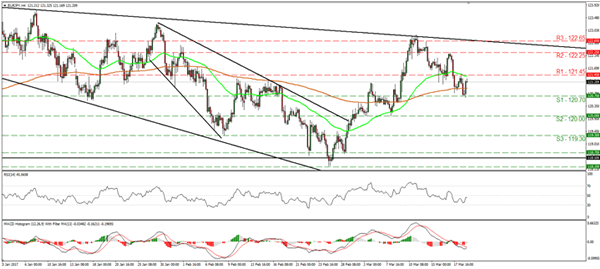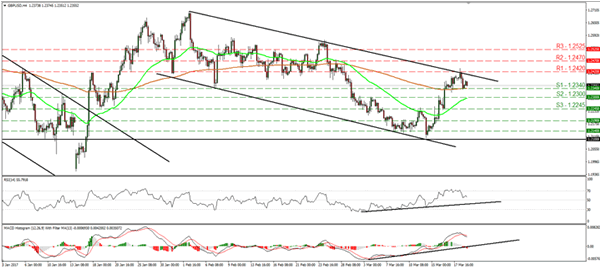Overnight, Emmanuel Macron, a centrist politician and former economy minister, was seen as the winner of the first French Presidential debate. According to a snap opinion poll, Macron was more convincing than his four rivals. Market participants may have interpreted this as diminishing Le Pen’s chances to win, which propelled the euro higher after the debate ended. The poll also showed that the second most convincing candidate was Mélenchon, with Fillon and Le Pen tied for third place.
According to the debate poll, Le Pen could even fail to make it to the second voting round, which suggests that political risks may be receding in Eurozone. As such, we think that the near-term path for the euro is to the upside. EUR/JPY rebounded from 120.70 (S1) in the aftermath of the debate and during the early European morning Tuesday, it looks to be headed for the 121.45 (R1) resistance zone. Although the structure on the 4-hour chart still suggests a short-term downtrend, the positive sentiment towards the common currency could result in more upside extensions, at least today. A decisive break above 121.45 (R1) is likely to open the way for our next resistance of 122.25 (R2), marked by the peak of the 17th of March.
The case for further euro gains is also amplified by the increased market attention towards the prospect of "ECB normalization". The latest signals from the Bank suggest there is diminished willingness among the Governing Council for any more extraordinary easing measures. However, in order to assume that the medium-term outlook of EUR/JPY has turned back positive, we would like to see a decisive close above the downside resistance line taken from the peak of the 14th of December and the 123.50 area. The main risk to our EUR-positive view is incoming French polls showing Le Pen gaining back ground, despite her seemingly poor performance in this debate. In such a case, EUR/JPY gains are likely to remain limited below the aforementioned downside resistance line.
UK PM May to officially trigger Article 50 next week
According to recent media reports, the UK government is set to trigger Article 50 of the Lisbon Treaty and commence the formal process of leaving the EU on Wednesday, the 29th of March. The office of the PM also expressed its desire for the negotiations to begin at the earliest after the triggering. Even though the UK’s intent to invoke Article 50 before the end of March had been signalled multiple times and should not have come as a surprise to investors, the pound still came under selling pressure on the news.
In our view, once the negotiations begin, the forthcoming direction of sterling will likely be decided by media headlines regarding what each side is actually pursuing. Having said that, considering that much of the "hard Brexit" rhetoric may already be priced into the battered pound, we believe that the political risks surrounding GBP are likely asymmetrical. Any positive developments during the negotiation process could generate a bigger upside reaction than the corresponding downside in case of the anticipated "hard Brexit" stance. Besides the political developments, today’s inflation data may prove critical for sterling as well (see below).
RBA minutes drag the Aussie somewhat lower
Overnight, the minutes of the RBA’s March policy meeting showed a slightly more cautious tone compared to the meeting statement. The Bank highlighted that employment growth had continued to be concentrated in part-time jobs and that wage growth remained low, suggesting that the labor market may not be as strong as the headline employment figures indicate. As a reminder, the RBA has a twin mandate to promote full employment in addition to price stability and as such, these signals may have been interpreted by investors as increasing somewhat the probability for further easing. As such, the AUD came under selling interest in the following hours, though the reaction was not huge. Despite these cautious signals, we do not expect the RBA to actually take any action in the foreseeable future. The Bank has repeatedly highlighted that further rate cuts could amplify financial stability risks, something that we believe will be enough to stay the Bank’s hand, absent some serious deterioration in the outlook for inflation and/or employment.
Today’s highlights
During the European day, the UK will release its CPI data for February. The forecast is for both the headline and the core rates to have risen, something supported by the UK services PMI for the month, which showed that rapidly rising input costs led to the largest increase in prices charged by service providers for eight and a half years. At the latest BoE gathering, some members noted that they would consider reducing stimulus should there be any further upside news on the prospects for growth or inflation, while Kristyn Forbes actually voted for an immediate hike. This suggests that in case the CPIs accelerate further as expected, then in addition to the "Brexit" negotiations, another big market theme for GBP traders is likely to be whether the BoE will reduce its asset purchases, or even hike rates at some point in the foreseeable future. Such speculation could bring the pound under renewed buying interest. GBP/USD is currently trading between the support of 1.2340 (S1) and the downside resistance line drawn from the peak of the 2nd of February. Accelerating CPIs could prove the catalyst for a clear break above the aforementioned downside line and the 1.2420 (R1) resistance, something that could pave the way for the 1.2470 (R2) hurdle. Switching to the daily chart, we see that Cable remains within the wide sideways range between 1.2100 and 1.2850. Thus, the medium-term outlook remains flat in our view. Nevertheless, the fact that the latest recovery came from near the lower bound of that sideways channel increases the possibilities for the rate to continue trading north within the range.
As for the speakers, we have three on the agenda: Bank of England Governor Mark Carney, New York Fed President William Dudley and Kansas Fed President Esther George. Any comments on monetary policy from Governor Carney may be of special interest to investors, as he will be speaking shortly after the release of the inflation data.
EUR/JPY

Support: 120.70 (S1), 120.00 (S2), 119.30 (S3)
Resistance: 121.45 (R1), 122.25 (R2), 122.65 (R3)
GBP/USD

Support: 1.2340 (S1), 1.2300 (S2), 1.2245 (S3)
Resistance: 1.2420 (R1), 1.2470 (R2), 1.2525 (R3)












